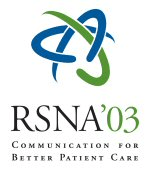
Abstract Archives of the RSNA, 2003
Susanne Goehde MD, PRESENTER: Nothing to Disclose
Abstract:
HTML
Purpose: Screening or early detection of disease in the non-symptomatic subject theoretically is possible with MRI, as it is highly accurate in detection of disease which goes along with morphological changes. Furthermore, MRI is well accepted in the general population, which is another prerequisite for screening. If generalized diseases or a combination of different diseases are screened for, whole body concepts have to be applied. The goal of this study was to evaluate a new whole body MR imaging concept for detection of atherosclerotic and colonic disease as well as to determine the frequency of side findings in mainly healthy subjects.
Methods and Materials: We examined 331 subjects (male: n=246, female: n=50, mean age 51y). The MR protocol encompassed the brain, the arterial system (whole body angiography), the heart, the lungs, and the colon. For MR-colonography all subjects had undergone standard preparation for bowel cleansing. Subjects with a history of myocardial infarction, stroke, cancer or diabetes (n=33) were excluded from subsequent analysis.
Results: All remaining 298 examinations were performed with a mean in-room-time of 63 minutes. Only in 8 MR-colonographies remaining stool hampered reliable diagnosis. 21% of subjects exhibited signs of atherosclerotic disease in the cerebrovascular, cardiovascular or peripheral vascular system. Two cerebral infarctions and one previously unknown myocardial infarction were encountered; the 37 cases (12%) with peripheral vascular disease included focal dissection of the aorta (n=1), and high grade internal carotid artery stenoses (n=2). 12 colonic polyps and 9 pulmonary lesions were correctly detected. 29% of all exams revealed relevant additional findings in non-targeted organs including the liver, kidneys, pancreas, and spine. Follow-up or radiological confirmation could be obtained in 75% of all cases with relevant findings (128 of 169); only one false positive result was encountered: a suspicious vertebral contrast-enhancing lesion was later proven to be e hemangioma.
Conclusion: MR-based screening is feasible and provides a high rate of true-positive relevant findings in non symptomatic subjects. The outlined protocol uses established sequences and offers an overview over two of the most common diseases: atherosclerosis and colonic cancer. Further studies must provide cost- and risk analyses, and the outcome of subjects with unsuspected side findings must be followed.
Goehde MD, S,
Whole Body MR Screening for Cardiovascular and Malignant Disease: Feasibility and Initial Experience in 300 Subjects. Radiological Society of North America 2003 Scientific Assembly and Annual Meeting, November 30 - December 5, 2003 ,Chicago IL.
http://archive.rsna.org/2003/3106018.html

